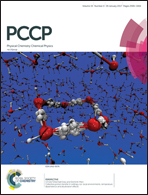Excited state properties of β-carotene analogs incorporating a lactone ring†
Abstract
Carotenoids possessing a carbonyl group along their polyene backbone exhibit unique excited state properties due to the occurrence of intramolecular charge transfer (ICT) in the excited state. In fact, the ICT characteristics of naturally occurring carbonyl carotenoids play an essential role in the highly efficient energy transfer that proceeds in aquatic photosynthetic antenna systems. In the present study, we synthesized two short-chain polyene carotenoids incorporating a lactone ring, denoted as BL-7 and BL-8, having seven and eight conjugated double bonds (n = 7 and 8), respectively. The excited state properties of these compounds were directly compared to those of their non-carbonyl counterparts to clarify the role of the carbonyl group in the generation of ICT. The energies of the optically allowed S2 states for BL-7 and BL-8 were found to be more than 0.3 eV (2400 cm−1) below those of non-carbonyl short β-carotene homologs. Ultrafast spectroscopic data demonstrated various solvent polarity-induced effects, including the appearance of stimulated emission in the near-IR region in the case of BL-7, and significant lifetime shortening of the lowest-lying singlet S1 excited states of both BL-7 and BL-8. These results suggest that these compounds exhibit ICT characteristics.



 Please wait while we load your content...
Please wait while we load your content...